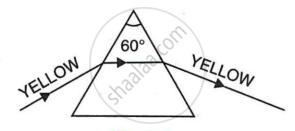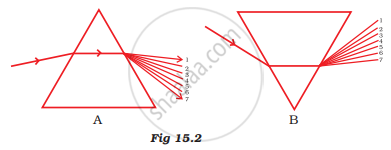Advertisements
Advertisements
प्रश्न
As light rays pass from air into a glass prism, are they refracted towards or away from the normal?
उत्तर
As light rays pass from the air into a glass prism, they are refracted towards the normal because glass is denser than air.
APPEARS IN
संबंधित प्रश्न
A student traces the path of a ray of light through a triangular glass prism for different values of angle of incidence. On analyzing the ray diagrams, which one of the following conclusions is he likely to draw?
(A) The emergent ray is parallel to the incident ray.
(B) The emergent ray bends at an angle to the direction of the incident ray.
(C) The emergent ray and the refracted ray are at right angles to each other.
(D) The emergent ray is perpendicular to the incident ray.
Make two diagrams to explain refraction and dispersion.
The splitting up of white light into seven colours on passing through a glass prism is called:
(a) refraction
(b) deflection
(c) dispersion
(d) scattering
Out of the following, the colour of light having the maximum wavelength is:
(a) violet
(b) indigo
(c) green
(d) orange
The diagram below shows the path taken by a narrow beam of yellow monochromatic light passing through an equiangular glass prism. If the yellow light is replaced by a narrow beam of white light incident at the same angle, draw another diagram to show the passage of white light through the prism and label it to show the effect of prism on the white light.

What conclusion do you draw about the nature of white light in part (b)?
In the following diagram, the correctly marked angles are
(A) All
(B) Only ∠i and ∠A
(C) ∠i, ∠r and ∠A
(D) ∠i, ∠A and ∠D
In an experiment to trace the path of a ray of light through a triangular glass prism, a student would observe that the emergent ray
(a) is parallel to the incident ray.
(b) is along the same direction of incident ray.
(c) gets deviated and bends towards the thinner part of the prism.
(d) gets deviated and bends towards the thicker part (base) of the prism.
Define dispersion of light.
State the correct sequence (1-7) of colours in the spectrum formed by the prisms A and B, shown in Figure 15.2.

